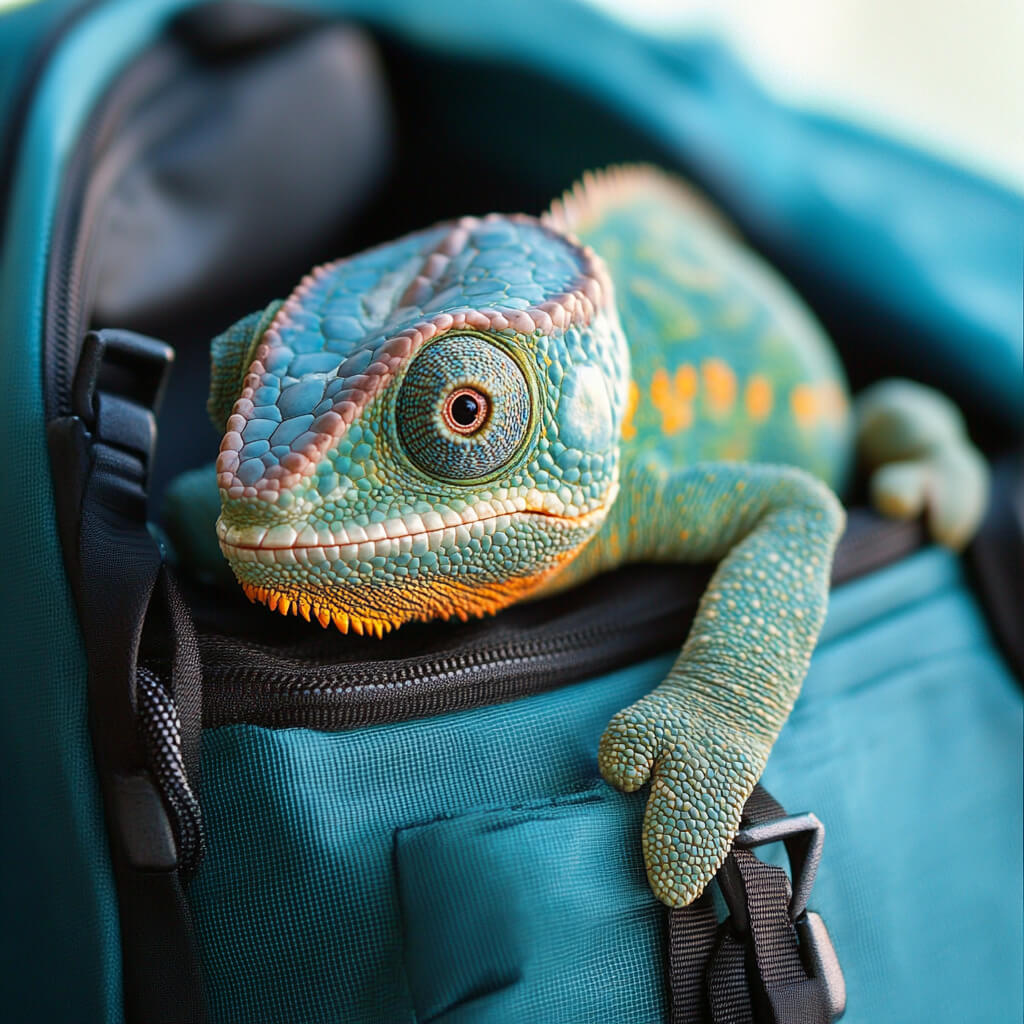No, it’s not recommended. While oranges aren’t toxic to chameleons, they’re not an ideal food choice for several reasons:
- High acidity
- High sugar content
- Low nutritional value for chameleons
Chameleons have sensitive digestive systems, and the high acidity of oranges can cause stomach upset.
Additionally, the sugar content in oranges is higher than what chameleons typically consume in their natural diet.
🦎 Chameleon Tip: It’s best to stick to foods that closely mimic a chameleon’s natural diet in the wild.
Understanding chameleon diet
Before we tackle the orange question, it’s important to understand what chameleons typically eat.
In the wild, chameleons are primarily insectivores, meaning their diet consists mainly of insects.
However, some species also consume plant matter occasionally.
| Wild chameleon diet | Captive chameleon diet |
| Insects (crickets, flies, grasshoppers) | Commercially raised insects |
| Small lizards or birds (larger species) | Gut-loaded insects |
| Leaves and fruits (some species) | Vegetables and fruits (in moderation) |
For pet chameleons, a diet based on safe foods is crucial for their health and longevity.
While insects should make up the bulk of their diet, many chameleon owners wonder if they can offer fruits as treats.
Potential risks of feeding oranges to chameleons
Let’s break down the risks associated with feeding oranges to chameleons:
Acidity concerns
Oranges are highly acidic, with a pH level ranging from 3.0 to 4.0. This acidity can:
- Irritate a chameleon’s digestive tract
- Lead to diarrhea or other digestive issues
- Potentially cause mouth sores
Sugar content and chameleon digestion
Chameleons aren’t adapted to process high amounts of sugar. Consuming sugary fruits like oranges can lead to:
- Weight gain
- Dental problems
- Potential metabolic issues
Orange peel toxicity
While the flesh of the orange isn’t toxic, the peel can be problematic:
- Contains essential oils that may be harmful to chameleons
- Can be difficult to digest
- May pose a choking hazard
Safe fruit alternatives for chameleons
If you’re keen on offering your chameleon some fruit treats, there are safer options than oranges.
Here’s a table of chameleon-friendly fruits:
| Fruit | Benefits | Serving suggestion |
| Papaya | High in calcium, low in phosphorus | Small, seedless pieces |
| Figs | Good source of calcium | Tiny portions, remove seeds |
| Berries (strawberries, blueberries) | Rich in antioxidants | Cut into small pieces |
| Mango | Vitamin A source | Ripe, soft pieces without skin |
Remember, fruits should only make up a small portion of your chameleon’s diet – think of them as occasional treats rather than staple foods.
Maintaining a balanced diet for your chameleon
A balanced chameleon diet is crucial for their health and well-being.
Here’s what you should focus on:
- Insects: The main component of a chameleon’s diet. Offer a variety of gut-loaded insects like crickets, dubia roaches, and silkworms.
- Vegetables: Dark, leafy greens can be offered regularly. Examples include collard greens, mustard greens, and dandelion leaves.
- Supplements: Dust insects with calcium powder and provide a multivitamin supplement as directed by your vet.
- Hydration: Ensure your chameleon has access to clean, fresh water for drinking and misting.
🦎 Chameleon Fact: Some chameleon species are more herbivorous than others. The Oustalet’s chameleon (Malagasy giant chameleon), for example, eats more plant matter than most other species.
Chameleon feeding tips and best practices
To ensure your chameleon gets the most out of their meals, follow these feeding tips:
- Establish a feeding schedule: Adult chameleons typically eat every other day, while juveniles may need daily feeding.
- Offer appropriate-sized prey: The insects should be no larger than the space between your chameleon’s eyes.
- Gut-load insects: Feed insects nutrient-rich foods before offering them to your chameleon.
- Provide variety: Rotate between different types of insects and vegetables to ensure a range of nutrients.
- Use feeding cups: This can help prevent substrate ingestion and make it easier to monitor food intake.
Frequently asked questions
How often can chameleons eat fruit?
Fruits should be offered sparingly, no more than once or twice a month. They should never replace the main insect-based diet.
What vegetables are good for chameleons?
Dark, leafy greens like collard greens, mustard greens, and dandelion leaves are excellent choices. Avoid lettuce as it has little nutritional value.
Can baby chameleons eat oranges?
No, baby chameleons should not eat oranges. Their diet should consist primarily of small, gut-loaded insects appropriate for their size.
Are there any fruits chameleons should never eat?
Avoid citrus fruits, including oranges, lemons, and grapefruits. Also, steer clear of avocados as they can be toxic to many reptiles.
How can I tell if my chameleon is getting a balanced diet?
A healthy chameleon will have clear, bright eyes, a full body, and smooth skin. Regular vet check-ups can help ensure your chameleon is receiving proper nutrition.
Conclusion
While chameleons can technically eat small amounts of orange without immediate harm, it’s not a recommended part of their diet.
The risks outweigh any potential benefits, and there are many safer fruit options available if you want to offer your chameleon a treat.
Remember, the key to a healthy chameleon is a diet that closely mimics what they would eat in the wild – primarily insects, with some plant matter for certain species.
By focusing on a balanced diet and appropriate feeding practices, you’ll help ensure your chameleon lives a long, healthy life.
Always consult with a reptile veterinarian for personalized advice on your chameleon’s diet.
Every chameleon is unique, and their nutritional needs may vary based on species, age, and overall health.







Leave a Reply